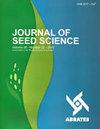Accelerated aging methodologies for evaluating physiological potential of treated soybean seeds
IF 1.2
4区 农林科学
Q3 AGRONOMY
引用次数: 2
Abstract
Abstract: This work evaluated the efficiency of accelerated aging test to determine the physiological potential in treated soybean seeds with fungicides and insecticides, in addition to analyzing the concordance between the results obtained by different accelerated aging methods with the actual results of the physiological quality in seeds after the storage. The study was divided into two experiments, both with entirely randomized delineation, with four replications. In the first experiment, seed germination was evaluated after imposing some treatments that were arranged in a 3 x 2 x 3 factorial scheme: seed treatment (imidacloprid + thiodicarb; fipronil + thiophanate methyl + pyraclostrobin; no treatment); vigor levels (high; low); and accelerated aging (traditional; saturated NaCl solution; no aging). In the second experiment, seedling emergence was evaluated after applying some treatments that were arranged in a 3 x 2 x 2 factorial scheme: seed treatment (imidacloprid + thiodicarb; fipronil + thiophanate methyl + pyraclostrobin; no treatment); vigor levels (high; low); storage time (0 and 135 days). The accelerated aging methods were efficient to determine the physiological potential of the seeds, in which, the NaCl method presented better results. The physiological potential of soybean seeds decreased throughout storage and the application of chemicals in seed treatment impaired the germination and emergence percentages, regardless of the active ingredient used. The accelerated aging method with NaCl presents greater agreement with the actual storage results.评价处理大豆种子生理潜能的加速老化方法
摘要:本文评价了加速老化试验测定杀菌剂和杀虫剂处理过的大豆种子生理电位的有效性,并分析了不同加速老化方法测定结果与种子贮藏后生理品质实际结果的一致性。该研究分为两个实验,都是完全随机描述,有四个重复。在第一个试验中,采用3 × 2 × 3因子方案对种子进行处理(吡虫啉+硫代威;氟虫腈+噻吩酸甲酯+吡唑啉酯;没有治疗);活力水平(高;低);加速老化(传统的;饱和NaCl溶液;没有老化)。在第二个试验中,采用3 × 2 × 2因子方案对幼苗出苗率进行评价:种子处理(吡虫啉+硫代威;氟虫腈+噻吩酸甲酯+吡唑啉酯;没有治疗);活力水平(高;低);储存时间(0天和135天)。加速老化法测定种子生理电位效果较好,其中NaCl老化法效果较好。在贮藏过程中,大豆种子的生理电位下降,而在种子处理过程中,化学药剂的使用降低了种子的发芽率和出苗率,与使用的活性成分无关。NaCl加速老化法与实际贮藏结果吻合较好。
本文章由计算机程序翻译,如有差异,请以英文原文为准。
求助全文
约1分钟内获得全文
求助全文
来源期刊

Journal of Seed Science
Agricultural and Biological Sciences-Agronomy and Crop Science
CiteScore
2.00
自引率
30.00%
发文量
28
审稿时长
12 weeks
期刊介绍:
From 2017 the Journal of Seed Science (JSS) will circulate online version only.
Original scientific studies and communications, not yet published or submitted to another journal for publication and written in Portuguese or English, will be accepted for publication. For manuscripts submitted in English, the authors should provide an adequated version.
The SCIENTIFIC COMMUNICATION is a category of scientific manuscript which describes a technique, an equipment, new species or observations and surveys of limited results. It has the same scientific rigor as the “Scientific Articles” and the same value as a publication. The classification of a manuscript as a SCIENTIFIC COMMUNICATION is based on its content and scientific merit but it can be a preliminary study, simple and not definitive on a certain subject, with publication justified by its uniqueness and contribution to the area.
The Editorial Board of the JSS may invite leading authors of recognized reputation to compose specific Review Articles covering topics of their specialization that will convey to the scientific community the state-of-the-art knowledge related to the specific theme.
 求助内容:
求助内容: 应助结果提醒方式:
应助结果提醒方式:


